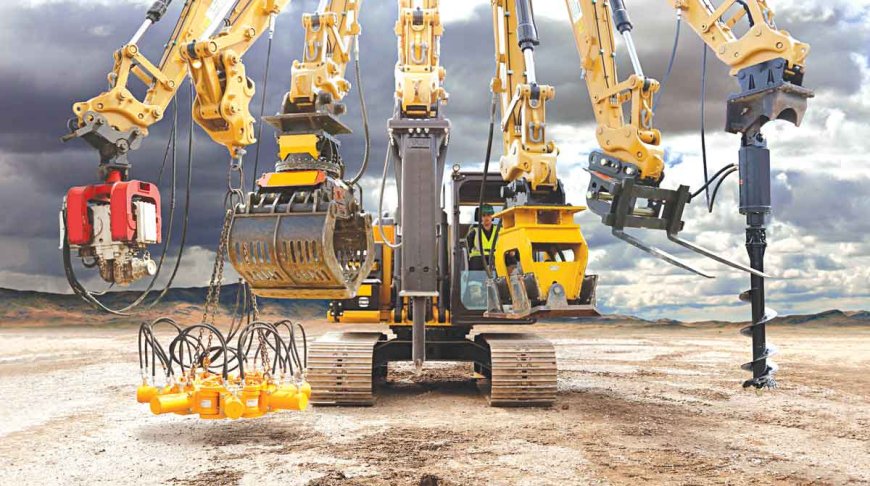Revolutionizing Construction Equipment: The Power of Advanced Attachments
Construction equipment attachments are the unsung heroes of the construction industry, often overshadowed by the larger machines they enhance. However, these attachments play a crucial role in increasing efficiency, versatility, and productivity on construction sites. Equipment Timeslooks into the types

Construction equipment attachments are the unsung heroes of the construction industry, often overshadowed by the larger machines they enhance. However, these attachments play a crucial role in increasing efficiency, versatility, and productivity on construction sites. Equipment Times looks into the types of equipment attachments, materials commonly used in the construction of attachments, customized attachment solutions, after-sales support and upcoming products or developments in the sector.
In recent years, there has been a paradigm shift in the world of construction equipment attachments, as technology and innovation have given rise to a new generation of tools that are transforming the industry. This feature explores the cutting-edge advancements in construction equipment attachments that are revolutionizing the way we build.
One of the most remarkable developments in construction equipment attachments is their newfound versatility. Modern attachments are designed to be multifunctional, offering a wide range of applications with a single tool. For instance, a single excavator attachment can serve as a hydraulic hammer, a grapple, and a bucket, eliminating the need to switch between various tools. This not only saves time and labor but also reduces the overall cost of equipment ownership.
Precision and Efficiency
Attachments have become more precise, thanks to advancements in automation and control systems. Technologies such as GPS and telematics have made it possible to achieve precision digging, grading, and other operations with minimal human intervention. This level of precision not only improves the quality of construction projects but also reduces material wastage, making construction more sustainable.
Enhanced Safety
Safety is paramount in the construction industry, and modern attachments are designed with this in mind. The integration of sensors and cameras into attachments provides operators with real-time information about their surroundings, reducing the risk of accidents. Some attachments are also equipped with collision avoidance systems, which can automatically stop the equipment if it senses an impending collision, preventing accidents before they occur.
Environmentally Friendly Solutions
Environmental concerns are driving innovation in construction equipment attachments. With the increasing emphasis on sustainability, many attachments now use alternative power sources, such as electric or hybrid systems. These eco-friendly attachments not only reduce emissions but also offer cost savings in the long run.
Digital Connectivity and Remote Operation
Attachments are increasingly becoming part of the Internet of Things (IoT). They can be monitored and controlled remotely, allowing for better fleet management and predictive maintenance. This digital connectivity ensures that equipment is always in optimal working condition, reducing downtime and maintenance costs.
Customization for Unique Projects
One size does not fit all in the construction industry, and attachments are now customizable to meet the unique demands of specific projects. From specialized buckets for digging in tight spaces to attachments designed for underwater construction, the ability to tailor these tools to the job at hand is a game-changer for the industry.
Extended Lifespan and Durability
Innovations in materials and manufacturing processes have resulted in attachments that
are more durable and have longer lifespans. This not only reduces the need for frequent replacements but also contributes to cost savings over time.
The future of construction equipment attachments is incredibly promising. As technology continues to evolve and environmental concerns become more pronounced, we can expect even more groundbreaking advancements in this field. These attachments are not merely tools but partners in the construction process, adding value by improving efficiency, safety, and sustainability.
In a world where construction projects are becoming more complex and demanding, the role of advanced attachments cannot be understated. As they continue to adapt and innovate, construction equipment attachments are poised to shape the industry’s future, making construction processes more efficient, safer, and sustainable.
Market for Attachments
In the dynamic world of construction, efficiency and versatility are paramount for successful project execution. Construction equipment attachments play a pivotal role in achieving these goals by enabling heavy machinery to perform a wide range of tasks with precision. This feature explores the thriving market of attachments used in construction equipment, highlighting their importance, key trends, and the latest innovations driving this industry forward.
The Significance of Construction Equipment Attachments
Construction equipment attachments are specialized tools that can be fitted onto heavy machinery such as excavators, loaders, bulldozers, and more.
They transform the capabilities of these machines, making them suitable for various tasks, from earthmoving and material handling to demolition and road construction.
The use of attachments saves time and labor costs, making construction projects more efficient and cost-effective.
A Growing Market
The market for construction equipment attachments is experiencing rapid growth, driven by the global construction boom and the demand for more versatile, adaptable equipment.
The market is expected to expand further due to urbanization, infrastructure development, and the need for sustainable construction practices.
Developing economies, in particular, are witnessing increased adoption of attachments to meet their construction needs efficiently. Attachments come in various categories, including buckets, breakers, crushers, grapples, hammers, and augers, among others.
Each category serves specific construction purposes, catering to the diverse requirements of the industry. Manufacturers are continually innovating to create attachments that are more durable, efficient, and capable of handling increasingly complex tasks. As the construction industry places a greater emphasis on sustainability and safety, attachment manufacturers are developing eco-friendly and safety-enhanced attachments.
Noise reduction, dust suppression, and emissions control are vital factors in the development of new attachments, addressing environmental concerns. Safety features such as advanced control systems and sensors help prevent accidents and enhance operator protection.
Hits: 5








